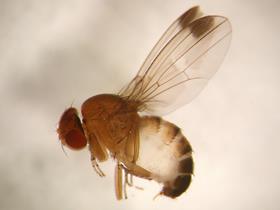
The spotted-wing drosophilia (SWD) fruit fly was found in small numbers on six UK soft fruit farms in 2013, according to a national monitoring process.
A total of 24 flies were found on fruit farms in traps trialled during the research project. Of all traps used, researchers found that Gasser bait and a synthetic bait developed in the US, were very effective.
East Malling programme leader Jerry Cross said research had found that it was vital to remove fruit waste from the crop. “Researchers are recommending that fruit waste is managed with anaerobic treatment in sealed bins, which is very effective at controlling the pest and minimising the risk of SWD.”
He added that SWD was found to be most attracted to wild hosts, particularly woodland, hedgerows and field margins.
The fruit fly, which originates in Asia, only appeared in August this year due to the cold winter and late spring. It is present across much of England but has not yet been found in Scotland.
Although SWD numbers will decline during winter, growers are being urged to start monitoring processes and control measures as soon as the weather gets warmer in early Spring.
Cross said: “We are encouraging growers to continue with good field hygiene practices and control measures throughout the 2014 season, in order to minimise the impact of SWD on crops.
“The cross-industry working party will continue to assess and share the results of the 2013 research with growers and further refresher workshops are also being planned for early 2014.”
Chairman of British Summer Fruits Laurence Olins, said: “We are confident that the short term issue of this new fly can be dealt with by using lessons from around the world, as well as through our high profile awareness campaign and new research.
“While the fly poses no threat to consumers’ health or enjoyment of our berries, we are keen that, as with any new pest, the fly is countered quickly and effectively to save growers the economic consequences of crop losses next year.”
Research into the lifestyle of SWD is being funded by BSF, Defra, the East Malling Trust, the Horticulture Development Company and the Worshipful Company of Fruiterers. Further EU funded research is also being conducted at Fera to discover new control measures, which will work in the UK.
SWD looks similar to the common fruit fly but males can be identified by a large spot on the front of each wing. The female can be recognised by a serrated edge on her body, used for penetrating fruit.






No comments yet